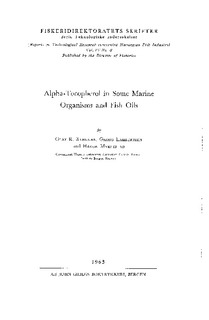| dc.description.abstract | A study has been made of a-tocopherol in some marine sources. Apart from commercial oils, which were of normal quality, care was taken to ensure fresh material. The a-tocopherol contents have been determined in eleven marine oils, four liver oils and seven body oils. The liver oils showed values from 35-700 µg per g. Cod liver oil ranged from 150-225, whereas Greenland shark liver oil showed very high contents, 300-700 µg a-tocopherol per g. The body oils normally contained 20-80 µg per g, thus eight samples of unspecified fish oils for hydrogenation showed 40-70 µg per g. Capelin oil showed high values, 50-230 µg per g. Fish livers varied greatly, the highest values were found in wrasse and catfish with respectively 108-180 and 290-300 µg a-tocopherol per g. Estimated. values for the liver oils were in the order of 200 µg per g for most species studied, exceptions were again wrasse and catfish with 1540 and 3100 µg per g, respectively. Values of this extremely high order were confirmed in additional analysis on extracted oils from these species. The muscle of ten species of fish were analysed. The a-tocopherol contents varied from 1.0 to 16 µg per g, with a clear tendency for fat fillets to show the highest values. Estimation of the contents in the fats showed values generally in the order 300-500 µg a-tocopherol per g. Some values were confirmed on extracted oils. The distribution of a-tocopherol in different organs were studied on male and female herring, cod and coalfish. There was a striking difference between the content in the liver of the male and female herring. Both were in the spawning state and the male contained ten times more than the female, the estimated values for the liver fat being respectively 7000 and 700 µg per g. No difference of importance could be observed between the testis (soft roe) and ovaries (hard roe), with 32 and 41 µg per g, respectively. The pyloric caeca showed similar values for all species, 8-18 µg per g. The a-tocopherol content of ten species of echinoderms and mollusks were investigated. The analysis refer to the whole animal except for the squid. The values were in the order 4-15 µg per g fresh weight, and approx. 100 µg per g dry weight. Exceptions were the littoral snails periwinckle and limpet, with approx. 40 and 150 µg per g fresh weight, or approx. 200 and 1000 µg per g dry weight, respectively. The high values in the limpet was confirmed in extracted oils. Fat extracted from the deep sea prawn showed 950 µg a-tocopherol per g. | no_NO |
